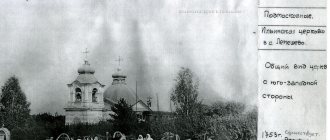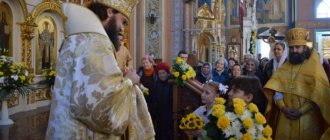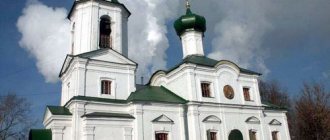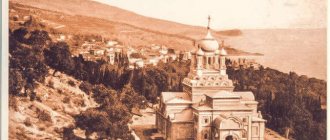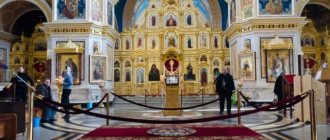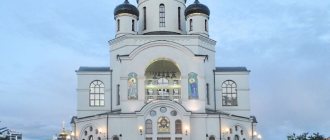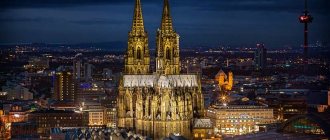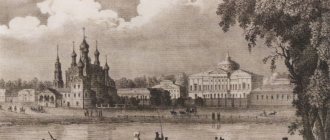| Moscow Elijah Church in Cherkizovo |
Moscow Church in the name of the Prophet Elijah in Cherkizovo,
Moscow diocese, historical residence of Moscow metropolitans
- Thrones: Exaltation of the Honorable and Life-Giving Cross of the Lord (main), Prophet Elijah (southern chapel), St. Alexy, Metropolitan of Moscow (northern aisle)
- Address: 107553, Moscow, st. B. Cherkizovskaya, 17 (metro station Preobrazhenskaya Square, Cherkizovskaya)
- Tel., 161-20-25
- Official site:
- On the map: Yandex.Map, Google map
Built in 1690 on the site of a burnt wooden temple, which stood here back in 1370.
In the 14th century, the village of Cherkizovo belonged to Tsarevich Serkiz, a native of the Horde, who sold it to his fellow tribesman Ilya Azakov. The latter, in all likelihood, erected the ancient St. Elias Church here in honor of his saint. The temple is directly connected with the name of many Russian metropolitans - and above all with St. Alexy. Metropolitan Alexy liked the picturesque location of the village and he purchased it for himself and his successors in rank and made the temple the summer residence of the Moscow patriarchs. Over time, especially under Saint Innocent (Veniaminov), the residence grew and was rebuilt.
During the Great Patriotic War, the believers and clergy of the temple collected 1,000,000 rubles for the construction of airplanes and sent them to J.V. Stalin. Stalin sent a telegram of gratitude in response. And the temple survived all the difficult years of Soviet rule. In the mid-20th century, icons from neighboring churches that were to be destroyed were brought to the temple. The rector of the temple at that time was Pavel Ivanovich Tsvetkov.
Currently, the Moscow Church of Elijah the Prophet in Cherkizovo has been returned to the status of a bishop's residence. The church operates a Sunday school for children and adults.
On the night of July 30, 2021, thieves entered the temple, stole decorations from three images - the icon of the Kazan Mother of God, the icon of the Mother of God "Unexpected Joy" and the icon of the Matrona of Moscow - and also broke into two donation boxes.
History of construction
Historical information has not preserved the exact dates of the founding of Cherkizovo. It is known that for some time the village was owned by a descendant of the Tatar kings, Andrei Serkizov, who converted to Christianity, and died in the battle on the Kulikovo Field.
At the end of the 14th century, Ilya Ozakov, also a descendant of the Tatars, was mentioned as the owner of Cherkizov near Moscow; he sold his lands to Metropolitan Alexy. Under the ownership of Ilya Ozakov Cherkizov, the first wooden Ilyinskaya Church was erected, in honor of the guardian angel of the owner of the village.
Temple of Elijah the Prophet in Cherkizovo, Moscow
From the high hill on which the Orthodox shrine, consecrated in 1590, stood, the ringing of bells could be heard for many miles around. The patrimony of the wonderworker Alexy, with its forest oak groves and picturesque banks of the Sosenka River, which flows into the Yauza, attracted royalty, who often visited the Ilyinsky Temple during their holidays in these parts.
According to the will of Metropolitan Alexy, after his death, the village and the Church of Elijah the Prophet of God went to the Chudov Monastery, and were in his possession until 1764.
At the end of the 17th century, during the time of Patriarch Andrian, the construction of a stone temple complex began after a fire in a wooden structure, which was consecrated by Metropolitan Josaphat. At the same time, a new chapel was consecrated in honor of Metropolitan Alexy.
Since 1874, the Cherkizovsky Church of the Prophet Elijah has been a separate parish. At the same time, the chronicle speaks of a church cemetery in Cherkizovo and a small chapel attached to it.
Interesting! Historians describe the Elias Shrine of the early 18th century as a magnificent building with amazingly beautiful stucco moldings, glass windows, a refectory and a bell tower with five bells.
The importance of the village of Cherkizovo increases with the appointment of the Chudov Monastery as a department of the Moscow Metropolis. The Moscow rulers Timofey (Shcherbatsky) and Platon (Levshin) often visited here.
In 1821, Moscow architect Matvey Kazakov supervised the reconstruction of the Cherkizovskaya Church, during which the central dome was supplemented with four side domes.
Interior decoration of the Elias Church
The Cherkizovskoe cemetery is the oldest Moscow necropolis; here in 1861 the famous Moscow holy fool Ivan Yakovlevich Koreisha, revered as a saint among the people, was buried.
With each rebuild, the architects carefully studied the original architecture of the building in order to preserve the uniqueness of the ancient shrine, but distortions were inevitable. With the expansion of the temple space, the altar in the northern aisle became wider due to the removal of the arched lintels of the windows, and the tent over the bell tower was enlarged.
Perestroikas at the end of the 19th century each time caused heated debate among historians and architects.
Construction of a stone church
During the Time of Troubles of the Polish-Lithuanian attack on Rus', the Elijah Church was burned by the enemy, but was soon restored. The construction of the stone Cherkizovsky church dates back to the reign of the ever-memorable Patriarch Adrian, the last patriarch of the pre-Petrine era.
Under his wise leadership, all the monastery buildings were rebuilt and several churches were erected. Since Cherkizovo in those years was considered the patrimony of this Moscow monastery, it must be assumed that appropriate attention was paid to it. In all likelihood, the construction of the Eliinsky Temple took place in 1689–1690. Thus, according to the testimony of the famous Russian writer of the 17th–18th centuries Karion Istomin, on June 18, 1690, the newly built Church of the Holy Prophet Elijah in Cherkizovo was consecrated by the abbot of the Chudov monastery, Archimandrite Joasaph, and cellarer German Lutokhin, and “decorated with all kinds of ornaments.” Chronicles of this period also report a parish cemetery where a wooden chapel stood.
It must be said that from the end of the 17th – beginning of the 18th centuries, there has been an increase in the population of Cherkizovo, due to which the number of parishioners increases, and the temple itself becomes more magnificent. According to the inventory of 1701: “... stone in the name of the Prophet Elijah, and in the chapel of Metropolitan Alexei with a refectory... in the altar there are two windows, and in the church there is one glass window... and in the refectory there are three glass windows in the windows, a mural stove, and on the refectory wall there is a bell tower stone, and there are five bells on it.”
By decree of Empress Elizabeth Petrovna and by decision of the Holy Governing Synod, the Monastery of the Miracle of St. Archangel Michael in Kolosy from a stauropegial metropolitan monastery with the establishment of the Moscow Metropolitan Department in it is transformed into the Moscow Cathedral Miracle Monastery with the residence of the Metropolitan of Moscow. In this regard, the importance of the village of Cherkizova is increasing.
Since 1764, the church in the name of the Holy Prophet of God Elijah leaves the compound and becomes a parish church.
A period of upheaval and recovery
Thousands of people with prayers and petitions have come to the holy prophet for several centuries; thanks to the intercession of Saint Elijah, temple services have not stopped since the founding of the church.
The shrine survived the terrible years after the revolution with minimal losses; services did not stop for a single day, only in 1929 the ringing of bells was prohibited.
In the early 30s, during the Easter celebration, the bell tongue came off, breaking through the roof, it got stuck in the floor, later all the bells were removed and confiscated by the Soviet authorities. Only the patronage of Elijah the Prophet saved the Cherkizovskaya shrine from closure during the construction of the metro.
Under the rector Pavel Tsvetkov, the Ilyinskaya shrine took under its protection the holy images of temples and monasteries that were subject to destruction. The threat of closure constantly hung over the Church of Elijah the Ordinary Prophet in Moscow, which led to the fact that it was not renovated at all until 1982.
Mosaic icon of the holy prophet Elijah on the facade of the temple
The ancient architectural monument reminded the authorities of itself with a sign on which it was written that the building was under state protection. The rector of the temple, Alexey Glushakov, achieved the restoration of the church, during which there were:
- interior spaces have been restored;
- the painting of walls and icons was updated;
- a clergy house was built.
An amazing discovery excited the entire Orthodox world when, during the replacement of old buildings in 1996, the icon of the holy prophet Elijah, which was considered lost, was discovered. Restorer Venedikt Suvorov and artist Sergei Zakharenkov supervised the restoration of holy images on the main iconostasis, preserving it in its original form.
Archimandrite Innokenty (Prosvirnin) blessed the painting of wall frescoes in the dome vaults in the style of the 17th century.
Church in the Soviet period
At the time when the Great Patriotic War unfolded, about 1 million rubles were collected by devout people and the leadership of this temple, which were sent to Stalin for the construction of aircraft. To which the leader sent a telegram of gratitude in response. It was thanks to this act that the temple managed to survive the difficult Soviet years without being damaged or destroyed. Already in the middle of the 20th century, holy images from neighboring churches began to be brought to the temple; it was these icons that were supposed to be destroyed, but thanks to the holy walls they were preserved.
Current state
The beginning of the new millennium was marked by the appearance of a forged fence around the temple complex. In 2006, the bells began to sing again, re-cast and donated to the ancient shrine.
Archimandrite Savva became the rector of the Church of the Holy Prophet Elijah in Cherkizovo in 2011, under his leadership Archpriest Chvilev, five priests, a protodeacon and a deacon.
The temple complex includes thrones:
- Exaltation of the Cross of the Lord;
- Saint Alexy, Metropolitan:
- Prophet Saint Elijah.
On August 2, the temple courtyard was completely filled with parishioners who came to the service on the occasion of the patronal feast day in honor of Elijah the prophet of God.
Cemetery Cherkizovskoye
The cemetery, which is located near the church, is one of the smallest in the entire city. Its name coincides with the name of the village in which it was located. In 1904, this cemetery was included in the burial grounds of the city of Moscow. Since 1998, an archive of registration of all buried people has been kept here. A special rental point for the necessary items for caring for graves is open at the cemetery. Today, only family burials are held on the territory; the cemetery is open every day and can be visited.
Shrines and patronal feasts
Pilgrims and guests of the capital, when visiting the Ilyinsky temple complex, rush to pray at the miraculous icons of the Mother of God:
- Life-giving source;
- Iverskaya, written on Athos;
- Uspenskaya;
- Jerusalem.
Worship in the Temple of Elijah the Prophet
There are always crowds around the holy image “Healing by St. Alexius of Hanshi Taidula” and the icon with the relics of the holy seven youths of Ephesus. When visiting the Cherkizovsky necropolis, visitors come with petitions and prayers to the grave of the holy fool Ivan Koreysha.
Important! The patronal feast of the main altar is the Exaltation of the Life-Giving Cross of the Lord, two chapels are consecrated in honor of Metropolitan Alexy of Moscow and the Prophet Elijah.
Ilyinsky parish in Cherkizovo: “People who care about cleanliness”
The dacha of St. Alexy, the amazing life of the seer Ivan Yakovlevich Koreisha and the unusual action of parishioners - cleaning the banks of the Cherkizovsky pond - the history and present of one of the most active Moscow parishes.
Heritage of Serkiz Bey Both the snow-white Iliya Temple rising on the hill and the pond built at its foot have a very ancient history. The first mention of the village of Cherkizovo dates back to the 14th century. It was named after its owner, boyar Andrei Serkizov, the son of the serving Tatar prince Serkiz (Serkiz Bey), baptized Ivan, the Kolomna governor. As the governor of the Pereyaslavsky regiment, Andrei Ivanovich Serkizov died as a hero in 1380 on the Kulikovo Field. Obviously, this village did not belong to the Serkizovs for long, because in the book “Preobrazhenskoe and the places surrounding it, their past and present,” which was compiled and published in 1895 by P.V. Sinitsyn, the first owner of the ancient village of Cherkizovo near Moscow in the 14th century was named another person - Ilya Ozakov. He also came from the Golden Horde, a Tatar who voluntarily converted to Orthodoxy. It is to him that we owe the first wooden church built, but not extant to this day, in the name of our heavenly patron, the prophet of God Elijah. It is also known that in the 60s of the 14th century, Ilya Ozakov sold his villages near Moscow to St. Alexy, Metropolitan of Moscow, an outstanding Russian church leader from the Byakont family. Among them, the village of Cherkizovskoye is mentioned, given according to the spiritual will of the metropolitan “to the monastery of the Holy Archangel Chud”, better known to us from history lessons as the Chudov monastery, named so in memory of the Miracle of the Archangel Michael in Khoneh, which, unfortunately, was destroyed in 1930, during the years of the atheism. Cherkizovo first appears to us in the spiritual letter of St. Alexy, found by Metropolitan Platon in the Chudov Monastery in 1779, where it is said that “the village was bought “with my silver,” so it is no coincidence that in the census books of the 17th century the village of Cherkizovo is called “the wonderworker Alexy’s patrimony.” By the way, a book with the same name was recently published - “The Wonderworker Alexy’s Estate,” published on the basis of historical facts under the leadership of the rector of the Iliinsky Church, Archimandrite Savva (Tutunov). But returning to those distant years, it is worth saying that Cherkizovo was a very remote outskirts, where everything was conducive to solitude and relaxation. It is no coincidence that Metropolitan Alexy chose this place among the forest oak groves located along the picturesque Sosenka River, a tributary of the Yauza, for his bishop’s dacha, where he usually moved in the warm season. This place served as a summer residence both for himself and subsequently for his successors. Bishop's dacha The revival and flourishing of the Iliinsky Church and the metropolitan residence dates back to the middle of the 18th century. This period is associated with the names of Metropolitans Timothy (Shcherbatsky), Platon (Levshin), St. Innocent (Veniaminov), the Apostle of Siberia and America. Known for his exquisite taste, Metropolitan Timofey built a whole complex of the bishop's courtyard with a palace part, outbuildings, and gardening projects. Later, on the initiative of Bishop Platon, the bishop's house built by Metropolitan Timothy was restored. During his time, birch trees appeared in the bishop's courtyard and a marvelous rose garden was built, fenced with a stone fence, which he preferred to care for himself, and where he really loved to be during his hours of rest. On September 30, 1868, from the Chudov Monastery, Metropolitan Innocent (Veniaminov), who had just assumed the Moscow see, was sent a report on the state of this bishop's metochion. It said that the bishop's house in the village of Cherkizovo near Moscow “has fallen into such disrepair that it is no longer possible to fix it.” And therefore, archpastoral permission was sought to lay a stone foundation for a new house. The new house, designed by the architect Vasily Nikolaevich Korneev, was built within two years. The original feature of this work of architecture is the Renaissance interpretation of the front facade of the house with its tetrahedral columns, arches and medallions. In general, it must be said that the fate of the bishop's residence in Cherkizovo is connected with a number of outstanding people. Usually, from early spring to late autumn, Metropolitan Macarius (Bulgakov) of Moscow and Kolomna lived here. Here he completed his fundamental theological work “History of the Russian Church” in 13 volumes. Here, at his dacha in Cherkizovo, on June 9, 1882, he completed his earthly journey. Metropolitan of Kiev and Galicia Vladimir (Epiphany) chose the bishop's house near a picturesque pond as his summer residence when he served as bishop in Moscow. In 1898, he took up the Moscow cathedra and immediately became actively involved in the life of the Chudov Monastery and its bishop's courtyard, paying great attention to the preservation of its historical landscape. Under him, the Church of the Prophet Elijah was improved and took on its current appearance: its reconstruction and interior painting were completed, as well as the construction of an elegant hipped bell tower. On May 23, 1899, Metropolitan Vladimir consecrated a new, already three-altared, church with a central border in honor of the Exaltation of the Holy Cross. Let us recall that Vladyka Vladimir was brutally murdered in 1918, becoming the first martyr in the twentieth century from among the hierarchs of the Russian Orthodox Church. After the October Revolution, this place was no longer treated with due reverence. In Soviet times, a repair and construction department was located in the wooden two-story building of the residence of Moscow metropolitans, and the house church that was here was destroyed. This house was not destined to survive to this day: it burned down twice - the first time in 1992, and 7 years later it was completely destroyed by fire. Only in 2012 the house was rebuilt and the interior decoration of the first floor was completed. By decision of His Holiness Patriarch Kirill of Moscow and All Rus', the residence has now become the venue for meetings of the All-Church Court, created by the Council of Bishops in June 2008. A village does not stand without a righteous man. When talking about this amazing place, one cannot help but mention that even in the godless Soviet times, prayer was not interrupted in the temple of Elijah the Prophet. Shrines from closing Moscow churches were brought here, and therefore today ancient icons have been preserved there as unique. And I would also like to remind you that Ivan Yakovlevich Koreysha, a unique and very famous personality, is buried near its walls. In the 19th century, he was known not only in golden-domed Moscow, the capital St. Petersburg or the provincial city of Smolensk, where this man of righteous life was born, who suffered for his love for his neighbor. For more than forty years he was in an insane asylum on Preobrazhenka, the first three of which were chained to a wall in a cold, damp basement. And only thanks to the fact that Dr. Vasily Fedorovich Sabler, a famous psychiatrist, doctor of medicine and just a kind person, was appointed to the Moscow Preobrazhenskaya Hospital, Ivan Yakovlevich was transferred to a bright, large room. But even here he managed to take up very little space - just a corner of a large room. Literally the whole of Moscow went to see Ivan Yakovlevich Koreisha. During his long stay, the Preobrazhenskaya Hospital flourished; its capital, since it was established to take 20 kopecks from each visitor to improve the life of the patients, amounted to several thousand rubles. Moreover, at the request of Ivan Yakovlevich, the poor were not charged an entrance fee. Between them he divided everything that was brought to him. Koreysha was so popular that he was included in the works of outstanding Russian writers under both actual and fictitious names. Fyodor Mikhailovich Dostoevsky wrote about him in “The Possessed,” Nikolai Semenovich Leskov in “A Little Mistake,” and Alexey Nikolaevich Ostrovsky in “The Marriage of Balzaminov.” Ivan Yakovlevich Koreisha died on September 19 (September 6, O.S.), 1861, on the day of remembrance of the Miracle of the Archangel Michael in Khoneh. With the blessing of Metropolitan of Moscow Philaret (Drozdov), they decided to bury Koreisha in Moscow, in the fence of the Cherkizovsky Church. And this also shows a connection with the Chudov Monastery, which formerly belonged to Cherkizovo. The Bishop respected the request of the deceased’s own niece, Maria, who was married to the deacon of this church, Nikifor, and he received the deacon’s position at the request of Koreishi to the same Metropolitan Philaret. Just as Ivan Yakovlevich attracted many people during his lifetime, so now his many admirers come to his grave. They gratefully bring flowers and pray. Through the prayers of the saint of God, many receive help and consolation in everyday and family needs, in sorrows and illnesses, healing from various ailments, including incurable ones, liberation from harmful passions, including alcoholism and drug addiction, about which many parishioners leave their written testimonies. How to get back to basics? Usually, on the feast of the Epiphany, people went to the bishop's pond, where the Jordan was built and the water was blessed, in a procession of the cross. Throughout the year, fish were caught in the pond, which was found there in large quantities, and residents of nearby houses used the water for drinking. True, today not only is it forbidden to drink from the once wonderful reservoir, but it is also strictly forbidden to swim in it. The entire coastal area is littered with construction debris and household waste. Actually, that’s why the Iliinsky parish decided on their own to save this unique place that the Lord had rewarded them with. Moreover, the clergy also called on Orthodox Christians to be more attentive to the environment. In February of this year, the Council of Bishops adopted the document “The Position of the Russian Orthodox Church on Current Environmental Issues,” which especially emphasized that it is the duty of a Christian to work in collaboration with everyone who is concerned about the state of the environment, thinking about preserving the health and normal life of people. And on June 16 of this year, more than twenty enthusiasts, having prepared garbage bags and work gloves, went to the pond for Sunday. One of the young parishioners of the temple, Olga Kulikovskaya, said that she grew up near this pond and, of course, its current condition cannot leave her indifferent. “Although vacationers are not deterred by this state of the pond,” Olga is surprised, “and the overall picture is complemented by abandoned bags and mountains of garbage that they leave behind after gatherings in nature. That’s why we went out on a Sunday in June to return the pond to its former appearance; we wanted to demonstrate by personal example the need to take care of our small homeland.” The girl believes that over time, such Sundays can develop from a one-time event into something more specific, becoming the daily concern of local residents about the place where they live. And he really hopes that next time the cleaning will involve not 20 people, but much more. Indeed, this time too, some vacationers, inspired by a good example, began to clean up around them. “One man from a company of fishermen watched our actions for a long time and after some time decided to approach us. And, having learned that we were cleaning the pond on our own initiative, he began to help us,” Olga noted with a smile. Moreover, not only the youth of the temple, but also older parishioners and children with their parents took part in cleaning the pond. And not only residents of the nearby metropolitan area of Cherkizovo. “Friends brought someone with them. And although some parishioners come to us from another district of Moscow, they did not remain indifferent, which made us very happy. I believe it is our Christian duty not to remain indifferent to natural problems, and we need to start from our small homeland, from our region, especially when the need for help is already visible to the naked eye,” said Olga Kulikovskaya. Of course, this event did not arise by itself, explains another active participant, Kirill Egorov. “We quickly responded to the appeal of our rector, Father Savva, to go out and clean up, because we all live side by side and we need to help each other. And to show others that they shouldn’t litter and that there are people who care about cleanliness,” Kirill noted. “It turns out that you can restore order around yourself with little effort?” – I asked Kirill, but he allowed himself to disagree with this conclusion. “I can’t say that it was “small,” he answered, “considering that we worked there for about three hours.” Quite a lot of effort was spent. It was clear how tired everyone was. It was very serious work. Everyone got carried away and began to thoroughly clean the area, although not all of it was cleaned, mainly the walking areas. But our initiative had an effect on those around us: many people who were relaxing also became inspired and began to rake garbage around them. I think this kind of action is very useful, it needs to be covered more widely and talked about at the parish. Afterwards we made a photo report about this event, which we placed on a stand near the temple. In addition, we had the idea to prepare posters and install them in places where people relax. Their meaning is that we care about the place where we live. So that everyone could see that they were cleaning here, and not the janitors who are paid, but the ordinary people who live here. In any case, such a social initiative will be beneficial and, perhaps, people will begin to think differently about it. “There is no need to fight for cleanliness - you need to sweep,” the famous writer Mikhail Zoshchenko once said. And really, isn’t it difficult, as Kirill Egorov, a parishioner of the Cherkizovsky church aptly noted, to simply get together those who care about cleanliness and, rolling up their sleeves, put things in order around them? After all, this amazing nature was given to us by the Creator himself, and was preserved by the care of many generations, as history shows, of wonderful people who not only admired it, but took care of and increased its beauty. So why don’t we follow their example?! After all, how much joy such a truly good deed brings is beyond words! Photo: Website of the Church of St. Prophet Elijah in Cherkizovo
Anna PANINA
print version
Tags:
Parish Community
